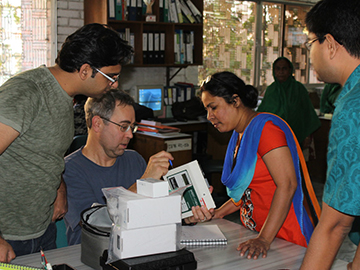
Research in Bangladesh suggests that arsenic poisoning from sources such as contaminated well water can cause cystic-fibrosis-like illness. Image: justinkendra/iStock
Since the 1980s, when its causative gene was sequenced, cystic fibrosis (CF) has been the “textbook” genetic disease.
Several thousand mutations have been identified in the CFTR protein, which regulates the flow of chloride in and out of cells. When CFTR is lost or abnormal, thick mucus builds up, impairing patients’ lungs, liver, pancreas, and digestive and reproductive systems and making their lungs prone to opportunistic infections.
Get more Harvard Medicine news here.
But new research could add a chapter to the textbook, pinpointing an unexpected environmental cause of CF-like illness. A study reported in the Feb. 5, 2015, New England Journal of Medicine found that people with arsenic poisoning have high chloride levels in their sweat—the classic diagnostic sign of CF.
Christopher Hug, Harvard Medical School assistant professor of pediatrics and a pulmonologist at Boston Children’s Hospital who treats children with CF, had seen clues in the research literature, particularly work from the lab of Bruce Stanton at Dartmouth College, indicating that arsenic causes the CFTR protein to break down. Hug knew his friend Maitreyi Mazumdar, HMS assistant professor of neurology at Boston Children’s, was studying arsenic poisoning’s neurological effects in Bangladesh.
“He asked me, ‘You study arsenic, why don’t you do sweat tests in this population?’” recalled Mazumdar, who also studies lead poisoning in affiliation with the Harvard T.H. Chan School of Public Health. “I replied, ‘Why don’t we study this together?’”
In November 2013, they visited Bangladesh with members of Mazumdar’s research team. Their findings could spark research on better treatments for both conditions and could prompt immediate measures for improving global health.
A man-made epidemic
Arsenic poisoning is epidemic in Bangladesh, the unintended result of public health efforts to reduce cholera and other diseases from fecally contaminated pond water.
In the 1970s, UNICEF and other organizations campaigned to get people to switch to well water, and hundreds of millions of wells were dug. Unfortunately, many of them turned out to have high levels of arsenic.

Today, an estimated 33 to 77 million people in Bangladesh—a third of the population—are exposed to high arsenic levels.
The skin lesions that sometimes accompany arsenic poisoning are often mistaken for leprosy, making it hard for people to get married; young Bangladeshi women with the lesions have been turned out of their homes. Arsenic poisoning is associated with higher rates of lung cancer and cardiovascular disease. Many exposed people have chronic noncancerous respiratory disease, and some develop diabetes—also a common complication of CF.
Mazumdar, Hug and Bangladeshi collaborators at Dhaka Community Hospital, Bangabandhu Sheikh Mujib Medical University and the Harvard Chan School studied 100 people from Pabna, an arsenic-endemic area in western Bangladesh.
Hug was immediately intrigued. “They struck me as people with chronic lung infections,” he said.

More than half of their sample had abnormal sweat tests and elevated arsenic levels in their fingernails. These subjects also had higher concentrations of arsenic in their drinking water. Many had symptoms of chronic lung disease and pulmonary function test results consistent with a CF diagnosis.
Subjects with abnormal sweat chloride on confirmatory tests had their CFTR gene completely sequenced. No one had a genetic diagnosis of CF.
New leads for treatment
Mazumdar and Hug believe their pilot study, supported by the Harvard University Center for the Environment and the Harvard–National Institute of Environmental Health Sciences at the Harvard Chan School, could fuel multiple directions of research.
The global health implications could be significant. Recognition of a CF-like illness in people exposed to arsenic would transform their treatment options. While targeted CF drugs would be prohibitively expensive (Vertex’s Kalydeco, for example, costs about $300,000 per year), many affordable interventions are available: chest physiotherapy, exercise to improve lung function, antibiotics for lung infections, monitoring for diabetes and nutritional treatments, such as pancreatic enzymes and vitamins.
“There are 30,000 CF patients in the United States,” said Hug. “In Bangladesh, there may be 1,000 times more people with symptoms like CF because of arsenic exposure.”
Nor is arsenic poisoning limited to Bangladesh. Arsenic is found in U.S. groundwater and is known to be associated with respiratory disease, diabetes and other health problems, with an estimated 13 million Americans at risk. The NEJM study suggests that patients exposed to arsenic should be monitored for CF-like symptoms that might not otherwise be considered.
Finally, a better understanding of the interaction between arsenic and the CFTR protein could fuel the development of more affordable drugs.
“Interestingly, not everyone exposed to arsenic has lung disease,” said Mazumdar. “There may be individual differences that could be exploited and that could lead to protective therapies for CF.”
Mazumdar and Hug hope to return to Bangladesh and do a larger study looking not only at lung disease but other complications typical of CF, such as diabetes, gastric motility dysfunction and reduced fertility. They would also conduct detailed biochemical evaluations.
Another patient population ripe for study is already at hand: Arsenic is currently part of the treatment of certain cancers, particularly adult leukemias.
“We could look at these patients to see if sweat chloride concentration changes after the administration of arsenic and whether they develop symptoms of cystic fibrosis,” said Mazumdar.
Adapted from a post on Vector, Boston Children’s clinical and research innovation blog.


